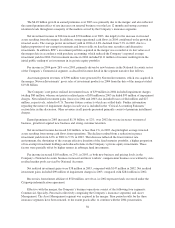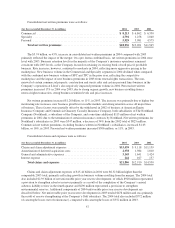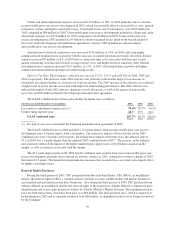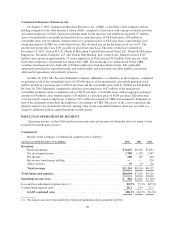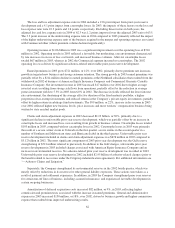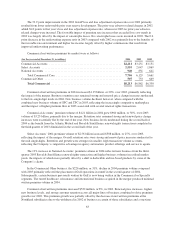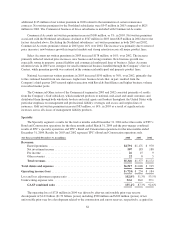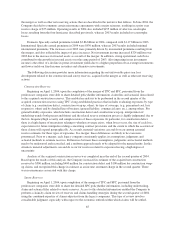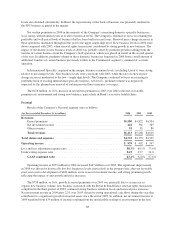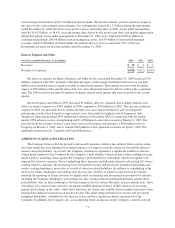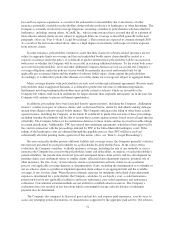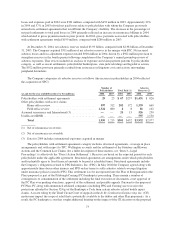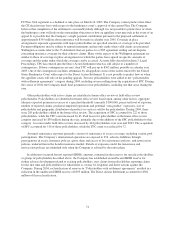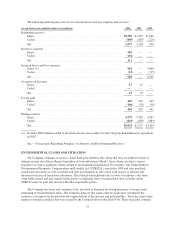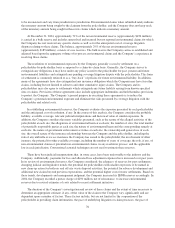Travelers 2004 Annual Report Download - page 78
Download and view the complete annual report
Please find page 78 of the 2004 Travelers annual report below. You can navigate through the pages in the report by either clicking on the pages listed below, or by using the keyword search tool below to find specific information within the annual report.estimates for dates of loss occurrence and evaluations of IBNR exposures for each insured. For example, as a
result of the detailed information obtained concerning contractors with reported claims, the Company considered
whether or not losses were incurred but not yet reported on one or more additional projects for each contractor
examined.
Also on April 1, 2004, the Company could begin to use this detailed information to compare SPC’s
assumptions, judgments and actuarial methods that were underlying the acquired reserves with its own
assumptions, judgments and actuarial methods. Similarities and differences were found to exist. Similarities
included, but were not limited to, recognizing claim reserves when it was determined that contractors and
commercial surety insureds were in default and thereby unable to meet their obligations, estimating initial IBNR
provisions, and periodically re-evaluating, at least quarterly, the adequacy of the reserves established based on
actual claims recorded and revised estimates of IBNR. Differences included judgments and methods related to
determining IBNR development factors and expected salvage, among others.
That these differences exist is not unusual for surety reserve estimates. Surety is a line of business for which
there are low frequency, high severity, very complex claims for certain exposures, particularly those related to
large construction contractors and commercial surety insureds. Determining the date of loss in these
circumstances requires a high degree of judgment. In addition, the claim reserve estimates even for reported
claims are also highly judgmental. These two factors, among others, combine to make IBNR reserve estimations
for surety extremely difficult. Due to this high degree of uncertainty, the informed judgments of different
actuaries could and do vary materially. As discussed above, in a merger, these differences are likely to be even
more pronounced.
The claim reviews and actuarial analyses were both completed near the end of the second quarter of 2004.
Based upon the results of these reviews and analyses, the Company increased its estimate of the acquired net
surety reserves by $300 million, net of $170 million of reinsurance, and recognized this change in estimate as an
income statement charge in the second quarter.
Prior to the merger and beginning in the third quarter of 2003, SPC disclosed that a large construction
contractor for which it had written several surety bonds was experiencing financial difficulty. Based upon an
analysis of the financial condition of the construction contractor that was performed in the third quarter of 2003,
a restructuring plan was adopted by the construction contractor, its banks, and SPC, among others, as a means to
minimize estimated losses. SPC monitored the progress of the construction contractor toward meeting the
requirements of the restructuring plan throughout subsequent quarters. SPC also estimated and disclosed its
estimated ultimate net losses related to this exposure, beginning in the third quarter of 2003 and updated each
quarter thereafter, including the effects of advances made or expected to be made to the construction contractor,
applicable collateral, co-surety participations and reinsurance. The size and complexity of these particular
construction contracts, coupled with the deteriorating credit quality of the construction contractor and the
inherent uncertainty as to whether it would meet the obligations of the restructuring plan, resulted in a high
degree of judgment in estimating potential losses.
A comprehensive analysis that began in the first quarter of 2004 was completed during the last half of the
second quarter. Based upon this analysis, the Company concluded that the contractor would not be able to meet
the targets set forth in its business and restructuring plans. Therefore, the Company moved from supporting the
contractor’s restructuring plan to adopting a workout plan as a means to minimize estimated losses. Under the
workout plan, the Company would no longer provide additional surety bonds for new projects of the construction
contractor. Also as part of the workout plan, the Company was able to implement additional accounting and
engineering procedures for each open project, which included using specialists to implement additional
forecasting, cash management, and reporting procedures, on both a project-by-project and consolidated level.
Based upon this second quarter change to a workout plan and the detailed financial analysis that was able to be
performed, the Company increased its estimate of the ultimate net loss by $252 million, including $9 million of
reinsurance. This estimate took into consideration paid amounts, net receivables, liquidated damages, overhead
66


